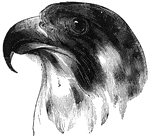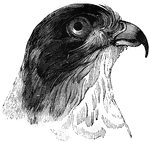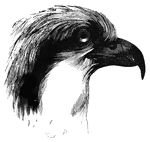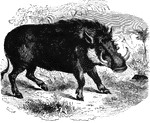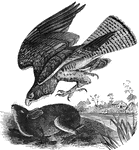
Common Buzzard of Europe
"B. vulgaris is twenty-two inches long, the head is large and the body heavy. Above, the color…
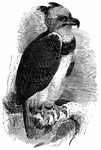
Harpy Eagle
Genus Harpyia, it is one of the largest, most fierce, and powerful eagles. It has a crest of…
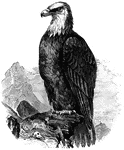
Bald Eagle
Bald (or white-headed) eagle, H. leucocephalus, common along sea-coasts, lakes, and rivers.
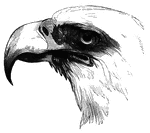
Head of a Bald Eagle
The head of a bald eagle. The distictive white plumage of this area earned it its nickname.
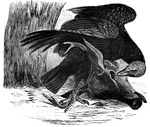
Black Vulture
Genus Coragyps, about the size of a small turkey. This one is feeding on a cow's head.
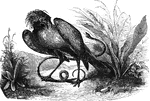
Secretary Vulture
G. serpentarius, known as the serpent vulture because it feeds on snakes. It has a distinctive…

Head of an Eagle Owl
Head of an eagle owl. It has large eyes for seeing at night, and a hooked beak for snaring its prey.
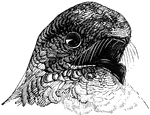
Head of a Goat-Sucker
Head of the goat-sucker. It bears some resemblence to an owl, with a large head and eyes, as well as…
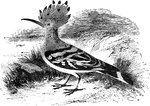
Hoopoe
Widely distributed over Africa, Asia, and Europe, the hoopoe has a distinctive crest of feathers on…

Sminthus Loriger
"Two and a half inches long, with a tail of nearly equal length. It is of a grayish-brown, with a black…

Barbary Mouse
"It is of a grayish-fawn color, with ten longitudinal brown strips along the back. Between the size…
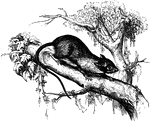
Free Mouse
Dendromys Typicus. "Size of the common mice, and are of a pearly-gray color, and have a black band running…
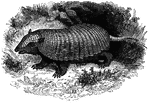
Giant Tatou
"In this carapace covers the body above and low down on the sides, but leaves the belly unprotected;…

Second Battle of Bull Run
"Second battle of Bull Run, fought Saturday, August 30th, 1862, between the Federal forces commanded…
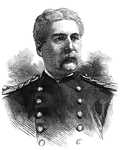
General Edward Hatch
"General Hatch, born in Bangor, Me., December 22nd, 1832. In April, 1861, he was a member of the District…

Indian Pangolin
"Its head is small, pointed, and conic; muzzle elongated and narrow; body rather stout; tail short and…
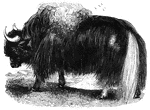
Yak
"The color of this animal in the wild and take, is black; the back and tail often white; the hair is…
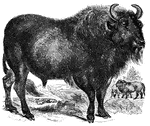
Aurochs
"The European species of the bison. Has a very broad head and arched forehead; the eyes large and dark;…
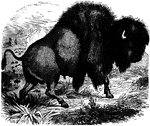
American Bison
"The head is very large and carried low; the eyes are small, black, and piercing; the horns are short,…
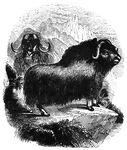
Musk Ox
"They frequent rocky regions desitute of woods, living on grass in the mild season and on lichens in…

Battle of the Wilderness
"The battle of the Wilderness, between General Grant and General Lee, May 5th and 6th, 1864. Our sketch…

Short Horn Cattle
"The head is small and finely formed, the eye bright and clear, the horn light in substance and waxy…

Hereford Cattle
"The hereford breed are of a medium or dark red color, with white faces and sometimes white on the throat,…

Jersey Cattle
"The Jersey cattle has a small deer-like head, muzzle fine and dark and encircled by a light color,…
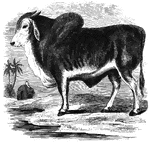
Indian Ox
"It has a long head, short, blunt horns, drooping ears, and a hump on its sholders sometimes weighing…

Indian Ox
"It has a long head, short, blunt horns, drooping ears, and a hump on its sholders sometimes weighing…
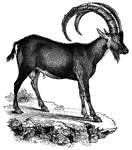
Ibex
"All noted for their large horns bending over the back, their love of the wild, rocky heights of the…

Battle of Belmont
"Battle of Belmont, Mo., opposite Columbus, Ky, November 7th, 1861- Federal forces commanded by U. S.…

Morning Detail
"The morning detail of the Fourth New Hampshire Volunteers going to work on the Hilton Head Fortifications.…
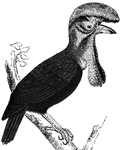
Umbrellabird
Feeding primarily on fruits, the umbrella-bird has two dstinctive crests of feathers, one rising from…
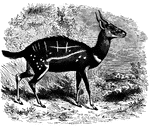
Guib Antelope
"About the size of a common deer, of a reddish-fawn color, but marked with white stripes along the back…
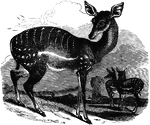
Female Gazelle
"Is one of the most celebrated of antilopes; it is about two feet high at the shoulder; its limbs are…
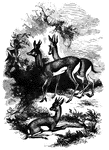
Ariel Gazelle
"Is one of the most celebrated of antilopes; it is about two feet high at the shoulder; its limbs are…
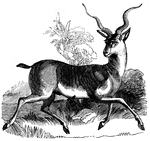
Common Antelope
"Its length is four feet; its height two and a half; the legs are long and delicate; the body round,…

Addax
"The body is five feet long, and height three feet. The general color is gray-ish-white, though the…
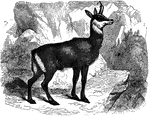
Chamois
"The horns are six or seven inches long, the body about three feet three inches, and the height at the…
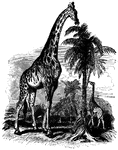
Giraffe
"The giraffe is the tallest of all ruminants, the males not uncommonly measuring fourteen and sometimes…

Giraffe
"The giraffe is the tallest of all ruminants, the males not uncommonly measuring fourteen and sometimes…

Moose
"This animal is the largest of the deer kind, being taller than thehorse. Its horns weigh fifty or sixty…
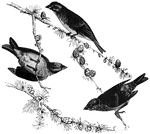
Purple Finch
The purple finch, also known as the American linnet, has a habit of erecting the feathers of its head…
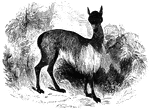
Vicuna
"Its color is reddish yellow on the back and whitish on the belly. It is a wild species, which is principally…
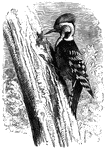
Middle Spotted Woodpecker
Found in Southern Europe, the middle spotted woodpecker has a black coat, with a crimson underside and…
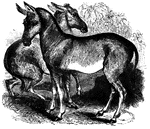
Hemiones
"In this the fur is short, smooth, and bright red bay; the legs are straw color; there is a broad, longitudinal…
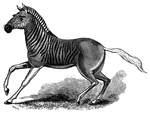
Quagga
"Its general color is brown, the head, neck, and withers striped or zebraed wth blackish-brown; the…
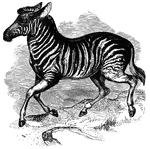
Dauw
"Is of a pale brown color; the underside of the body being whitish; head, body, and upper part of the…
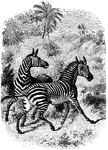
Zebras
"The ground color is white, or yellowish white, but the head, body, and legs to the hoofs are regularly…

African Elephant
"The head is rounded, the front convex instead of concave, and the nails on each hind-foot are three…
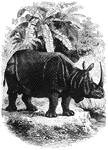
Indian Rhinoceros
"The head and neck are rather short; the eye is small and lateral, and the snimal cannot see in front,…
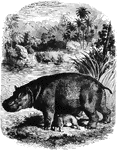
Hippopotamus
"Of this the muzzle is exceedingly thick and blunt, the head is very large, but the greater part of…

Front Royal
"Front Royal, Manassas Gap Railroad, Blue Ridge Mountains in the distance- the Federal army entering…

General John C. Fremont
"General John C. Fremont was head of the Western department during the Civil War."—E. Benjamin…

Guinea Hog
"It is of the size of a common hog; has long, narrow, straight ears, with a pencil of hair at the tips.…
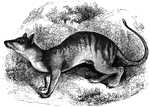
Tasmanian Wolf
"It is the size of a small wolf, with short, smooth, hair of dusky yellowish-brown color, barred on…
